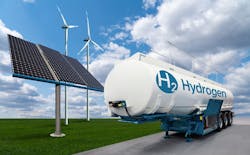Project Catalina project promising Multi-GW level Wind, Solar and Green Hydrogen combination in Spain
A group involving several renewable energy investors will partner on building a massive utility-scale wind and solar power project to connect to a 2-GW hydrogen electrolyzer in Spain.
Investment group Copenhagen Infrastructure Partners will work with transmission system operator Enagas, developer Naturgy, ammonia and crop giant Fertiberia and Vestas to develop, build and commission Project Catalina, which will combine 5 GW of future wind and solar power in Aragon and a planned 2-GW electrolyzer to create green hydrogen and ammonia, according to the announcement.
Project partner Vestas is one of the world's largest wind turbine manufacturers.
CIP’s release says the combined project could create 5,000 jobs and eliminate close to 1 million metric tons of carbon dioxide (CO2) annually. If full realized, the electrolyzer would generate enough green hydrogen to supply 30 percent of Spain’s current H2 demand.
“Spain, and in particular Aragon, offers good conditions for the development of this technology due to its excellent solar and wind resource, the political backing as well as the proximity to demand centers,” Søren Toftgard, partner at CIP, said. “We look forward to continue working with our partners to bring this project to life.”
Related story
Et tu H2? Can Green Hydrogen truly dethrone the Carbon Kings?
GM expanding hydrogen-powered generators into Mission Critical Microgrid market
Catalina Phase I is currently in an advanced development stage and is expected to be fully developed and permitted in less than two years. Construction is planned to start at the end of 2023.
The project will consist of 1.7 GW of wind and solar energy facilities as well as a 500-MW electrolyzer capable of producing more than 40,000 tons of green hydrogen per year. It will connect Aragón and Valencia via a pipeline transporting green hydrogen to supply a newly built, state-of-the-art green ammonia plant with annual capacity of 200,000 tons.
Green ammonia will be further upgraded into fertilizers within Fertiberia’s existing assets at Sagunto (Valencia), a potential breakthrough in the decarbonization of the agriculture industry.
The hydrogen produced will also be used for other industrial processes and blending into the natural gas grid. Catalina Phase I is applying for a grid connection.
About the Author
Rod Walton, EnergyTech Managing Editor
Managing Editor
For EnergyTech editorial inquiries, please contact Managing Editor Rod Walton at [email protected].
Rod Walton has spent 17 years covering the energy industry as a newspaper and trade journalist. He formerly was energy writer and business editor at the Tulsa World. Later, he spent six years covering the electricity power sector for Pennwell and Clarion Events. He joined Endeavor and EnergyTech in November 2021.
Walton earned his Bachelors degree in journalism from the University of Oklahoma. His career stops include the Moore American, Bartlesville Examiner-Enterprise, Wagoner Tribune and Tulsa World.
EnergyTech is focused on the mission critical and large-scale energy users and their sustainability and resiliency goals. These include the commercial and industrial sectors, as well as the military, universities, data centers and microgrids. The C&I sectors together account for close to 30 percent of greenhouse gas emissions in the U.S.
He was named Managing Editor for Microgrid Knowledge and EnergyTech starting July 1, 2023
Many large-scale energy users such as Fortune 500 companies, and mission-critical users such as military bases, universities, healthcare facilities, public safety and data centers, shifting their energy priorities to reach net-zero carbon goals within the coming decades. These include plans for renewable energy power purchase agreements, but also on-site resiliency projects such as microgrids, combined heat and power, rooftop solar, energy storage, digitalization and building efficiency upgrades.

